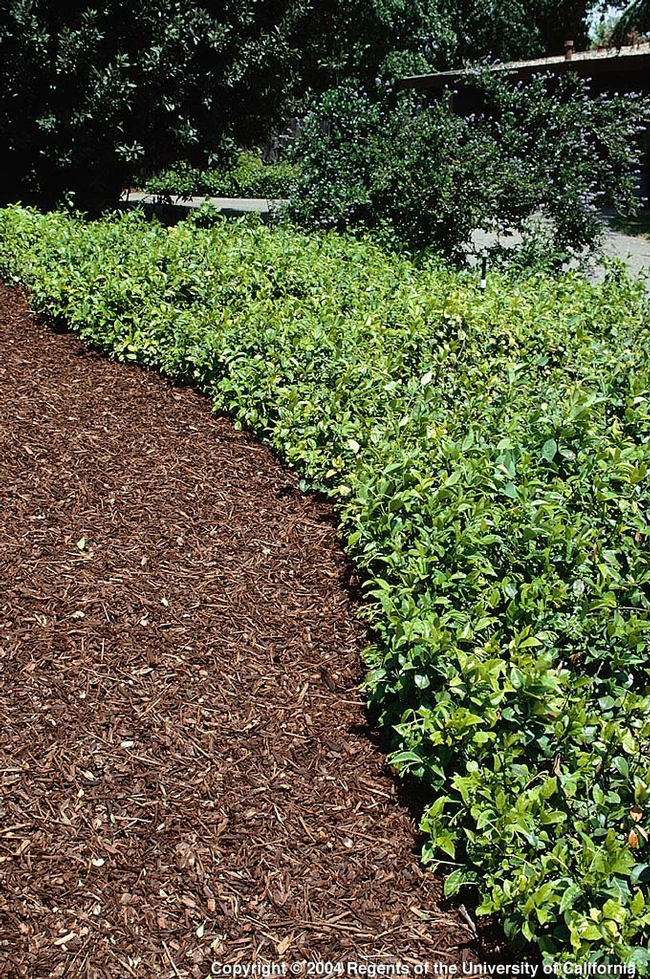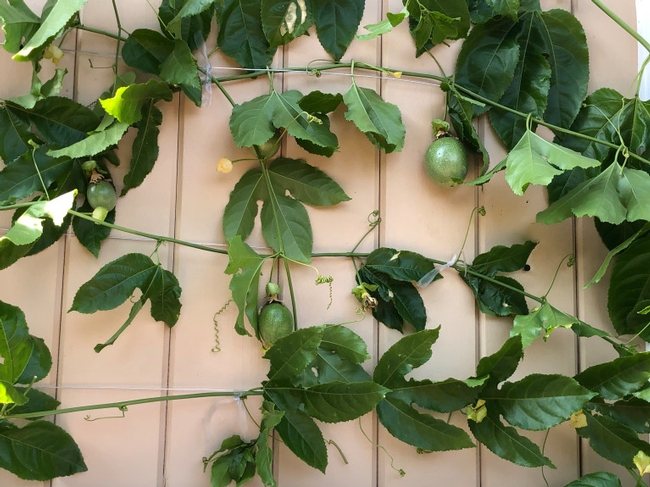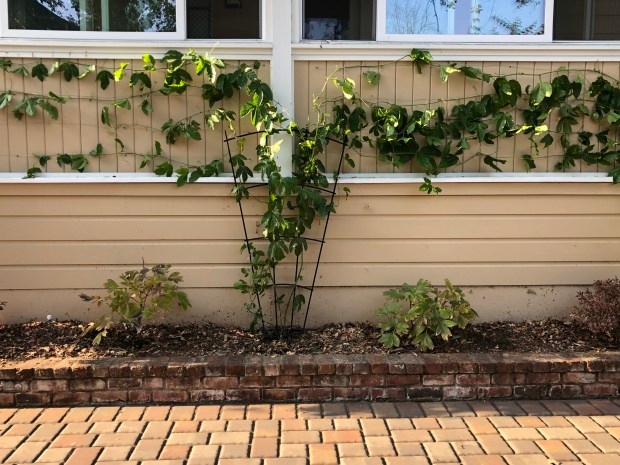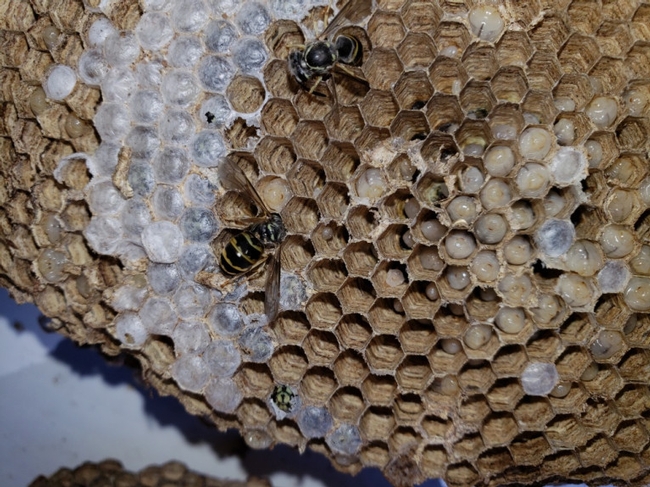Mulch selection makes a difference

Several years of drought have killed over a million trees in California since 2010. Most of those trees died in 2016, and more are doomed. Many local trees are not as healthy as they could be due to drought, bark beetle infestation, and disease. These trees have more dead leaves and twigs, making them susceptible to fire. Rather than allowing fire to race through your landscape, create spaces that slow or stop those flames.
California state law (PRC 4291) requires that all rural homes have a 100-foot defensible space. This space helps keep you, your family and our heroic firefighters safe. While suburban homes have different laws, fire safety is still critical and fire-safe gardening just makes good sense.
Defensible space is made up of two zones. Zone 1 is a 30-foot perimeter around any structures. Keeping Zone 1 fire safe means removing all dead vegetation from the ground, roofs and rain gutters, pruning tree branches at least 10 feet away from buildings, moving patio furniture away from trees and shrubs, and moving wood piles and other flammables into Zone 2.
Zone 2 extends 100 feet from your home. To keep Zone 2 fire safe, mow grasses to 4 inches or lower, rake up dead vegetation, and create spaces between trees and shrubs. This means removing any tree branches that are 6 feet from the ground or less, and pruning trees to be 10 to 30 feet apart, depending on the slope. Because shrubs can flame upward, they should be placed or pruned so they are three to six times their height from any trees, depending on the slope.
Mulch can add fuel to a fire, or slow its spread. The most dangerous mulches include shredded rubber or western red cedar, gorilla hair, and pine needles. Pine bark nuggets, Tahoe chips and other plant biomass from tree chipping operations create a moderate risk. Composted wood chip mulch does not create a significant fire risk.
There are no truly fire-resistant plants. Keep your home safe by planting low-growing, high-moisture plants closest to your home. When deciding where to install plants, imagine your home in the bottom of a shallow bowl. Plants should get taller, further from buildings. This helps draw fire away, rather than closer. Despite their name, evergreens are far more flammable than hardwoods.
If fire risk is especially high, remove shrubs and vines that touch your home (plant new ones later), and rake mulch at least 5 feet away from all structures.
Create a fire safety plan. Seriously. It takes 20 minutes and could save your life.
Above all else, in case of fire, get out and stay out. Everything else is temporary.
by UC Master Gardener Kate Russell
This article first appeared in the August 16, 2018 issue of the South Valley Magazine.

I planted it in a spot on the side of our home near the driveway where I had had a hard time getting anything to grow and really take off.
Let me tell you, I hit passion-pay-dirt with this little one-gallon plant! Not only has it taken off, it is trying to take over the side of my small, built-in porch.
Passiflora, or passion flower, is a genus of more than 500 species of flowering plants. Most are vines that have prolific tendrils for climbing, but some grow as hearty shrubs or even trees. Ninety-five percent of Passiflora edulis, or passion fruit, (often known as granadillas) come from South America. The rest come from Asia, Australia, and North America. They are edible, vining varieties that are coveted for their fruit as well as their juice. Fruit can either be purple, yellow or bright green and can range in size from as small as a pea to as large as a grapefruit.
They are sensitive to severe frost and prefer a moderately cool area when planted in warm climates. They like a relatively humid, moist area – but not too wet. If you decide to plant one, be sure to provide enough irrigation throughout the warmer months, but cut back on the water when the cooler weather hits.
Be sure to amend with organic compost, agriculture lime and bone meal. When I planted mine, I mixed in organic soil amendment, some compost and a little bit of slow-release organic fertilizer (as I do with most everything I plant).

Passionfruit are really beautiful plants with dark green foliage and unusual, striking flowers that look like little fringy-starbursts. Flowers can range from vibrant red and brilliant fuchsia to blue, pink, all shades of purple and even tricolored.
Although my plant had no tag, I believe it is the common purple granadilla because of its creamy white petals, deep purple crown and lime green ovary, anthers, and stigma.
It has been in the ground for six to eight months, and I am so impressed with how easy it has been to grow. I am trying to train it into an espalier form. I just trimmed away about half of the plant and made four horizontal branches across the length of my porch (see photo).
I have already harvested a couple of fruits and they are quite tasty.
Even though flowers only last for a day or two and plants only survive three to six years – I would highly recommend trying one out. If you have the patience, you can try to grow it from seed, but if you're are like me just pick up a transplant from your local nursery or farmer's market and give it a grow!
You can sometimes find fresh passion fruit and juice in your local market. It is also becoming a popular ingredient in drinks, cakes, icing, ice cream, and yogurt.
by UC Master Gardener Rebecca Jepsen
This article first appeared in the November 25, 2018 print issue of the San Jose Mercury News.

However, where they decide to nest can quickly turn them from friend to foe!
I was recently weeding a planting bed near our barbecue when I was stung in the abdomen and chest by a couple of aggressive little wasps. Our outdoor fire pit and dining area are in the same general area and we, and our dog, hang out there all the time. The wasps were flying around a stacked-rock retaining wall, so I sprayed some hornet and wasp spray into the crevices and figured I had solved the problem.
But a week later when I saw several wasps flying around the same area, I was surprised to see them emerging from the ground behind the wall. I decided I needed some help with the situation and immediately called Deb Conwayn with GirlzWurk in Saratoga. Deb is a beekeeper, does bee removal and relocation, and sells amazing honey. I was lucky to reach her right away and she came to our house the same day.
When we removed a large section of the stacked wall and dug a few feet into the soil, we found a huge, eight-layer yellowjacket nest. Deb guessed that there were at least 5,000 live yellowjackets in there! She smoked and removed the hive and vacuumed up the wasps. Apparently, they had created their nest in an abandoned gopher hole.
These yellowjackets were smaller and darker than most that I had seen so I sent the photos off to UC Davis for identification. Per Lynn Kimsey, director of the Bohart Museum of Entomology and professor of entomology at Davis, mine was a Vespula vulgaris, or common wasp. “It's the second most abundant yellowjacket in California after Pensylvanica, the so-called western yellowjacket.” said Kimsey.
Vesplua is a small genus of social wasps. They, along with their sister genus, Dolichovespula, are known as yellowjackets or yellow jackets. Vespula vulgaris have a stronger tendency to nest in the ground than other species.
Their normal habitat is dry grasslands and woodlands, however, they have certainly adapted to our urban areas. Only the queens survive the winter. They emerge in the spring to build their paper-like nests (made from chewed wood pulp) in hidden cavities like animal burrows, tree stumps, or in crevices like rock walls.
The initial brood of larva, which is cared for by the queen, hatch into workers who continue to build and protect the nest. They also care for the subsequent broods. Workers only live about two to four weeks and are replaced throughout the summer.
Again, all wasps can be beneficial and definitely serve a purpose. But, if you or a family member are allergic to their venom or they have taken up residence in a place that is intolerable, you may want to take action to relocate or eradicate them.
Deb Conway services most of the South Bay and can be reached at 408-373-0454. Find other good bee removal services at BeeRemovalSource.
by UC Master Gardener Rebecca Jepsen
This article first appeared in the October 28, 2018 print issue of the San Jose Mercury News.

The tarantula hawk (Pepsis formosa) is actually a spider wasp that can grow up to 2 1/2 inches long with a 4-inch-wide wingspan. This one had a beautiful blackish-blue, metallic body with vivid, bright orange wings. Some have shiny blue/black wings that match its body. It has long black antennae and six velvety black legs with hook-like claws on the ends.
As the name indicates, they prey on tarantulas, which they need as hosts for their larvae. (I have only seen one tarantula on my property in the six plus years we have lived here).
Only the females sting. She will fly low to the ground looking for spiders. When she finds a tarantula's burrow she will disturb the web, mimicking trapped-prey. When the tarantula emerges to inspect its web, she will sting and paralyze it. She will then drag the tarantula back into its burrow, lay a single egg on its body and then cover over the opening to the burrow.
When the egg hatches, the larva will feed on the still-living spider, avoiding the vital organs in order to keep the host alive as long as possible. After approximately three weeks to a month, the larva will emerge from the now-dead tarantula's body.
Adult tarantula hawks feed on pollen and nectar from flowers, and juice from fruits and berries. They seem to be especially attracted to milkweed, soapberry trees, and mesquite trees. Males live approximately two months or less; females can live longer.
Although the tarantula wasp is not aggressive and stings are relatively rare, it is reportedly one of the most painful stings of any insect in the world. The stinger is a fierce 1/3 of an inch long. The pain is said to be absolutely excruciating and so debilitating that you can lose control of your body. If you get stung, it is recommended that you lay down as quickly as possible to avoid stumbling and falling and causing further injury. An intense, burning pain will last for about 5 minutes. You may experience swelling and soreness around the area for a few days – but it will pass and is not life-threatening.
Fun facts:
- Species of tarantula hawks have been seen as far north as Utah and as far south as Argentina, with more than 250 species living in South America.
- Fifteen species of Pepsis are found in the United States, most of them residing in the desert.
- They are generally active during the summer months. They avoid the hottest part of the day (mine was out in early evening).
- Due to their extremely large stingers, they have very few predators; only roadrunners and bullfrogs will take them on.
- The tarantula hawk is the state insect of New Mexico.
So, definitely admire this wasp from afar, but avoid contact, and make sure your kids and pets do as well!
by UC Master Gardener Rebecca Jepsen
This article first appeared in the August 26, 2018 print issue of the San Jose Mercury News.
Growing plants in the off-season is easy, productive and beneficial to our native birds, bees and bugs

If you aren't planning to plant an edible garden this fall, at least plant some cover crops wherever you normally grow your summer garden – even in your raised beds. Cover crops are excellent for “fixing soil”. They not only provide needed nitrogen, they also help loosen soil, suppress weeds, and support native birds and bugs with their flowers and seeds.
Fava beans are one of my favorite cover crops, but they will grow for several months.
If you want to grow a quick cover and still have time for your cool-season garden, try buckwheat. It will germinate in about five days and be ready to turn under in about a month.
To get all the education and plants you need, don't miss the upcoming Fall Garden Market at Martial Cottle Park's Harvest Festival on October 6.
Celebrating the agricultural heritage of Santa Clara Valley and the newest park in the county, the festival will feature food, entertainment, park tours and more. Master Gardeners will host children's activities, a Green Elephant sale, and a Help Desk LIVE! where you can ask questions and bring in a plant or pest sample to have it diagnosed.
There will be educational talks all day long including “Growing Great Garlic”, “Growing Cool-Season Crops” and “Designing with Succulents”. You can also visit the Habitat, Pollinator and California Native gardens that are on-site.
If you haven't tried growing Asian greens, you are missing out. They are easy to grow, very productive and can be used in salads, stir-fries, and soups. There will Chinese broccoli, pak choi, and tatsoi at the market.
How about some Italian greens such as chicory, escarole, frisee, radicchio, and rapini? There will also be dozens of varieties of beets, broccoli, cabbage and cauliflower, chard and kale. And, if salad is your thing, you will have a dozen varieties of lettuce to choose from – or like me, you can plant them all and have your own salad bar! There will also be peas, turnips, onions and even kohlrabi, collards, rutabaga, turnips, and artichokes.
Also, don't miss out on the flowering beauties: Agrostemma, Clarkia, Linaria, Snapdragons and Sweet Peas. Flowers not only add beauty, but they also bring in the bees and beneficial insects that are necessary for pollination and fending off the “bad bugs” that can damage your garden.
Growing your own food, whether with your family or just on your own, is not only enjoyable, it is truly important! You will conserve water, waste less (no one wants to throw away what they have worked hard to grow), avoid using harmful chemicals, nurture your soil and help support and feed our native birds, bees and bugs. And most importantly, you will make a huge and positive impact on your children – kids will actually eat what they grow! So, head on out to one of our upcoming Fall Markets and dig in!
Here are the details for the three upcoming Santa Clara County Master Gardeners Fall markets. The main event is the one at Martial Cottle Park on October 6. Entrance is free, but there is a $6 fee to park.
September 29, 2018, 10 a.m. – 12:00 p.m.
Palo Alto Demo Garden
851 Center Dr.
Palo Alto, CA
October 6, 2018, 10 a.m. – 3 p.m.
Martial Cottle Park
5283 Snell Ave.
San Jose, CA
October 13, 2018, 10 a.m. – until sold out
Guglielmo Winery
1480 East Main Ave.
Morgan Hill, CA
by UC Master Gardener Rebecca Jepsen
Photo by Pam Roper
This article first appeared in the September 23, 2018 print issue of the San Jose Mercury News.

